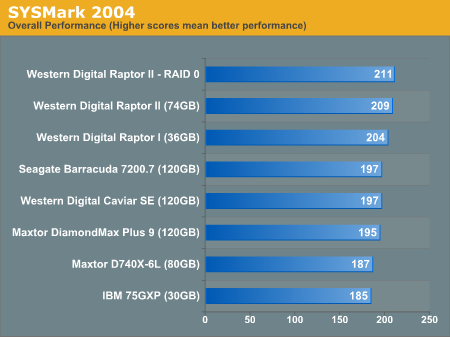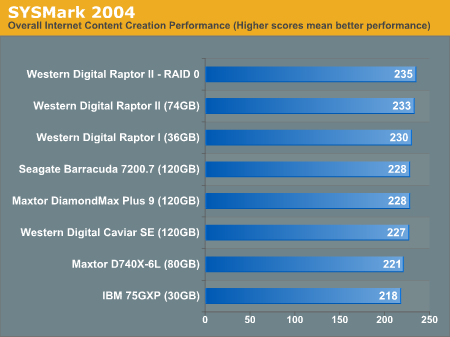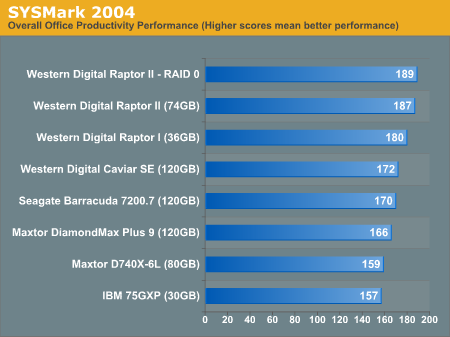Western Digital's Raptors in RAID-0: Are two drives better than one?
by Anand Lal Shimpi on July 1, 2004 12:00 PM EST- Posted in
- Storage
SYSMark Performance Summary
The overall SYSMark scores summarize what we've seen thus far:
The overall SYSMark performance graph pretty much says it all - a slight, but completely unnoticeable, performance increase, thanks to RAID-0, is what buying a second drive will get you.
As a recap, here's what happens with the Internet Content Creation suite:
"In this scenario, the content creator creates a product-related website targeting a broadband and narrowband audience. The user first renders a 3D model to a bitmap, while preparing web pages using a web site publishing tool. The user opens a video editing package, creates a movie from several raw input movie cuts and sound cuts and starts exporting it. While waiting on this operation, the user imports the rendered image into an image-processing package, modifies it and saves the results. Back in the 3D modeling software, the user modifies a 3D model and exports it to a vector-graphics format. Once the movie is assembled, the user edits it and creates special effects using one of the modified images as input. The user extracts content from an archive. Meanwhile, he uses an animation creation tool to open the exported 3D vector graphics file. He modifies it by including other pictures and optimizes it for faster animation. The final movie with the special effects is then compressed in a format that can be broadcast over broadband Internet. The web site is given the final touches and the system is scanned for viruses."

The trend continues with overall Internet Content Creation performance.
Also recapping, here's what happens in the entire Office Productivity suite:
"In this scenario, the office productivity user creates a marketing presentation and supporting documents for a new product. The user receives email containing a collection of documents in a compressed file. The user reviews his email and updates his calendar while a virus checking software scans the system. The corporate web site is viewed and the user begins creating the collateral documents. The user also accesses a database and runs some queries. A collection of documents are compressed. The queries' results are imported into a spreadsheet and used to generate graphical charts. The user then transcribes a document. Once the document has all the necessary pieces in place, the user changes it into a portable format for easy and secure distribution. The user edits and adds elements to a slide show template. Finally, the user looks at the results of his work (both the slide show and the portable document) in an Internet browser."

Even in our office productivity tests, we see that RAID-0 basically yields no performance improvement.










127 Comments
View All Comments
Insomniac - Thursday, July 1, 2004 - link
I was wondering how RAID1 reads back data. I thought if it was smart, it would use both drives and improve performance. If that wasn't the case, I wondered if you could choose which drive it read from. That way, you could get a WD Raptor II and a low cost 80GB hard drive to pair up. You get the redundancy and speed of the Raptor for a lower cost. What about RAID5? (I know the ICH5/6 doesn't support it, but I thought there were some chipset m,akers that did. I would like to see what that brings to the mix. Given the choice right now, I'd take redundancy over performance. Maybe RAID 5 can give you both for less than 0+1.Pollock - Thursday, July 1, 2004 - link
I really wish some regular 7200 RPM drives had been used, considering someone who can afford a 74GB Raptor won't care about the costs of RAID anyway. =P Besides, to me it seems like Raptors already perform so well that it's hard to find any performance gain anyway. I was also under the impression that a lot of people with SATA drives in RAID 0 were actually getting much more noticeable performance gains; i.e. outperforming lone Raptors. Well, whatever.goku21 - Thursday, July 1, 2004 - link
I noticed that they came to the conclusion of only using 2 drives in a RAID setup, but in my expereince the more drives the supposed increase in performance. Perhaps they should revisit this with 4 Raptors in a RAID setup.kuk - Thursday, July 1, 2004 - link
Just one small thingy ... why is the manufaturer stated in the article summary "3Com/U.S. Robotics"?parrybj - Thursday, July 1, 2004 - link
While your overall disk bound throughput may be higher, seek times are sill only as fast as the slowest drive in the array. Since seek time is a more important desktop performance metric, I would think there would be very little benefit to doing this.Marlin1975 - Thursday, July 1, 2004 - link
Well the review was nice if you are thinking of running 2 raptors on a ICH5/6 SATA ports, but what about the other 99% of use that may use VIA, SiS, etc.. and/or other 7200 rpm hard drives?Matthew Daws - Thursday, July 1, 2004 - link
I'd be interested in seeing how using RAID0 with older drives, or one old drive and a newer drive, works out. If you're upgrading your motherboard, then given that RAID comes "for free", it could be a good way to save money by buying a second, smallish hard-drive, and using your old hard-drive with this new one in parallel...parrybj - Thursday, July 1, 2004 - link
Very good article. The results are not surprising. I have one comment about RAID1. While in theory it is simply a data redundancy mechanism, in practice there are performance benefits. Any good RAID1 algorithm will use read optimizations that will allow for parallellism during read requests. Thus, under the right conditions, most RAID1 arrays will achieve higher read IOPS than a single drive. Also, there may be a performance hit on writes due to the fact that writes will only be as fast as the slowest drive.djm2cmu - Thursday, July 1, 2004 - link
#4: Excellent introduction to all the common RAID levels here: http://www.acnc.com/04_01_00.htmlnofuse - Thursday, July 1, 2004 - link
This article doesn't seem to be up to the standards I've come to expect from Anandtech.It would be more fair to say "Intel's onboard RAID 0 solution offers no performance gain." I'd be interested to see results from other RAID controllers. You can't take one product and make a blanket comment like "RAID 0 is not worth it." That would be like me reviewing an NVIDIA Vanta graphics card and saying "3D acceleration is not worth it."